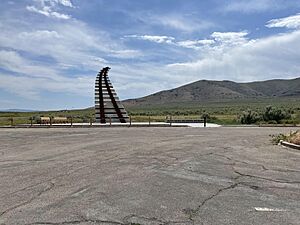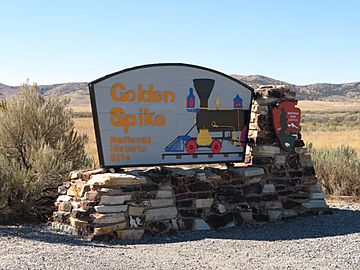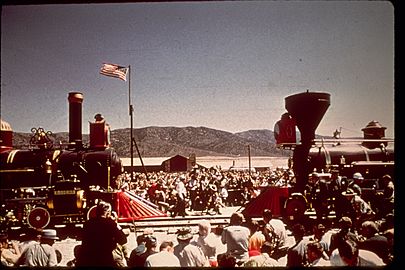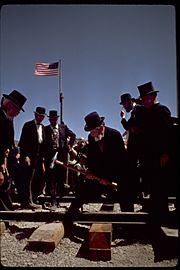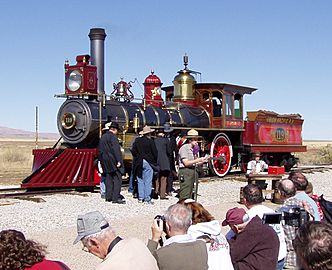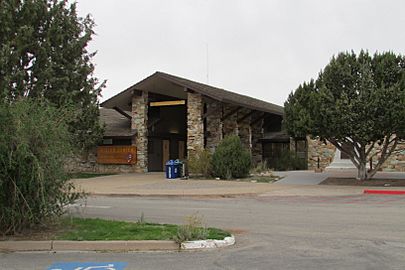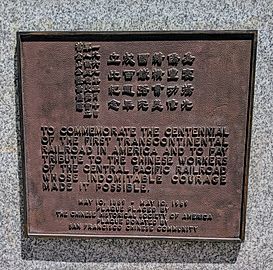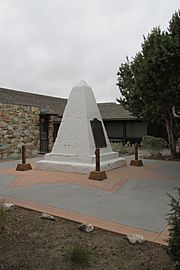Golden Spike National Historical Park facts for kids
|
Golden Spike National Historical Park
|
|

Replicas of the Central Pacific Jupiter and Union Pacific No. 119 locomotives at the Golden Spike National Historical Park
|
|
| Location | Box Elder County, Utah, U.S. |
|---|---|
| Nearest city | Corinne |
| Area | 2,735 acres (1,107 ha) |
| Built | 1868 |
| Built by | Central Pacific Railroad; Union Pacific Railroad |
| Visitation | 40,156 (2005) |
| NRHP reference No. | 66000080 |
Quick facts for kids Significant dates |
|
| Added to NRHP | October 15, 1966 |
| Designated NHP | April 2, 1957 |
The Golden Spike National Historical Park is a special place in Utah, United States. It's located at Promontory Summit, north of the Great Salt Lake. This park remembers a very important moment in American history.
It marks where the first Transcontinental Railroad was finished. On May 10, 1869, the Central Pacific Railroad and the Union Pacific Railroad tracks met here. This event connected the eastern and western parts of the United States by rail. The final joining of the rails was celebrated by driving a special golden spike.
Contents
What is the Golden Spike Park?
The Golden Spike National Historical Park covers about 2,735 acres. When it first started in 1957, it was much smaller, only 7 acres. Over time, more land was added to protect the historic railroad areas.
Today, the park includes the spot where the rails met. It also has areas called the west slope and east slope. These areas show where workers camped and where parts of the railroad were built. You can see places where the Central Pacific Railroad set a record. They laid "Ten miles of track in one day"! The park also includes the Big Fill and Big Trestle areas.
The original railroad line was stopped in 1904. The actual rails were taken up in 1942 to help with the war effort. But today, the park has 2 miles of rebuilt track. These tracks look just like the ones from 1869. Visitors can see what the railroad looked like back then.
The park welcomes many visitors each year. It helps people learn about this amazing part of history.
How the Park Was Created
The first monument at the site was a concrete pillar. It was built around 1916 by the Southern Pacific Railroad. You can still see it near the Visitor Center today.
A woman named Bernice Gibbs Anderson worked hard to save this historic spot. Starting in 1926, she wrote articles about local history. She believed the site should be a national memorial.
Bernice Gibbs Anderson led the Golden Spike Association. This group held the first re-enactment of the rail joining ceremony on May 10, 1952. Local volunteers acted out the historic event. Anderson wrote many letters to government officials. She urged them to create a monument at Promontory Summit.
Her efforts paid off! On April 2, 1957, the site became a National Historic Site. At first, local groups managed it. Then, in 1965, the U.S. Congress decided the federal government would own and run it.
Celebrating the Railroad's History
On May 10, 1969, 28,000 visitors came to celebrate the railroad's 100th anniversary. Bernice Gibbs Anderson was there too. A new Visitor Center had just been finished.
For the celebration, two old locomotives were brought in. They were decorated to look like the original Union Pacific No. 119 and Central Pacific Jupiter. These engines helped recreate the famous ceremony. Later, other replica engines were used.
In 1978, a plan was made to keep the park looking like it did in 1869. New, working replicas of the Jupiter and No. 119 locomotives arrived in 1979. They helped celebrate the 110th anniversary.
In 2006, a limestone arch in the park was renamed. It used to be called Chinaman's Arch. Now it's known as Chinese Arch. This change honors the many Chinese railroad workers who helped build the Transcontinental Railroad.
In March 2019, the site was given a new name. It became the Golden Spike National Historical Park. This new name shows that it includes many important historical landmarks.
On May 10, 2019, another big celebration took place. It marked 150 years since the railroad was completed. Many important leaders attended this special event.
Gallery
-
Re-enacting the driving of the Golden Spike (1969)
See also
- National Register of Historic Places listings in Box Elder County, Utah
- Jupiter (locomotive)
- Union Pacific No. 119
- List of heritage railroads in the United States
- List of transport museums
- Promontory, Utah
- Northern Pacific Railway Completion Site, 1883





